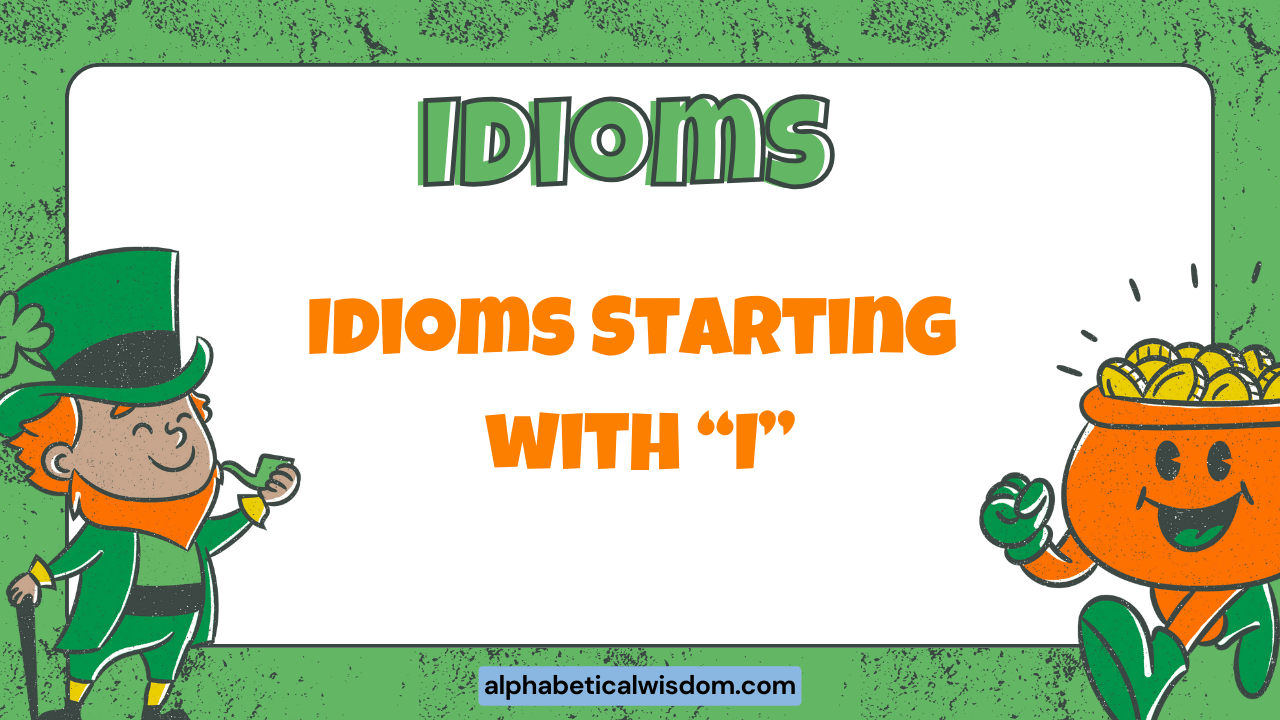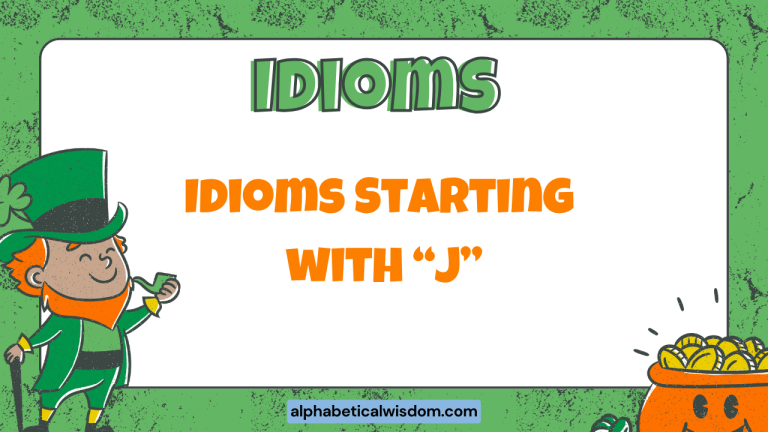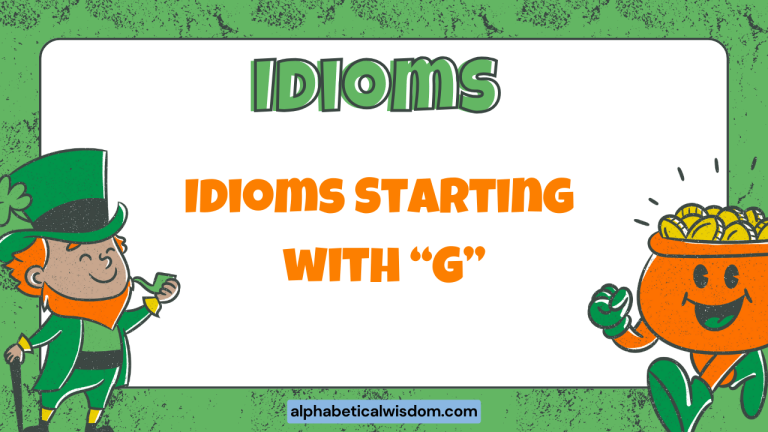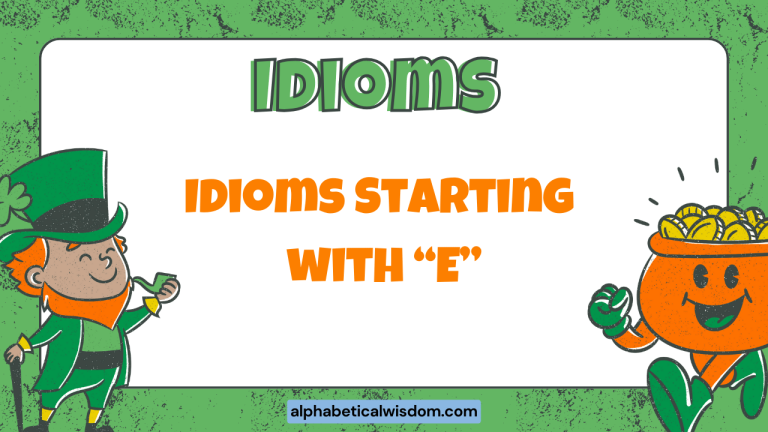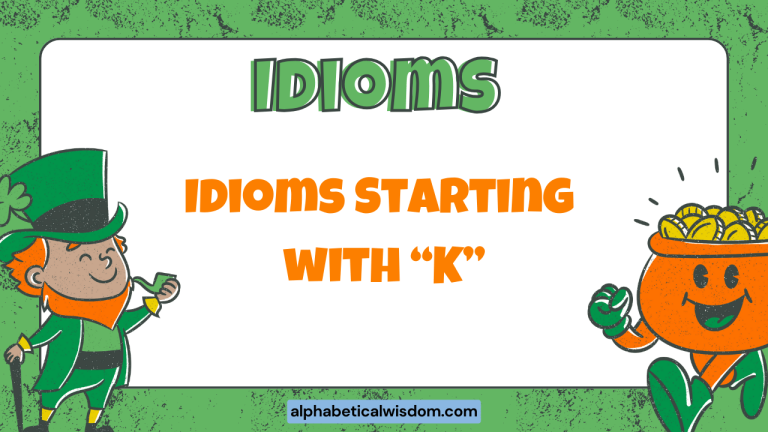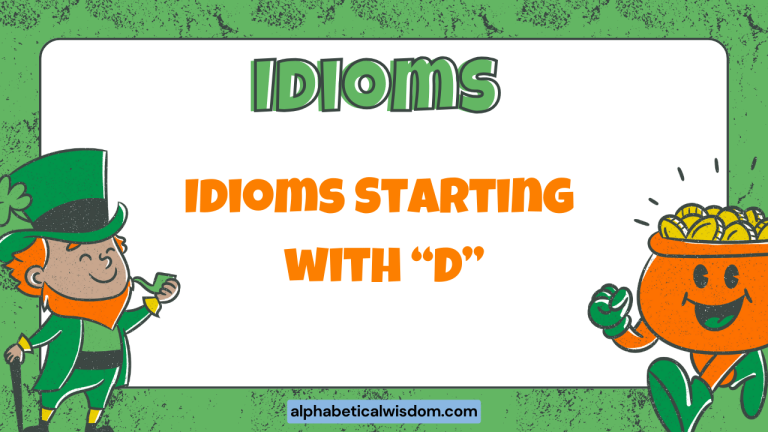Idioms Starting with I: Mastering English Figurative Language
Idioms are an integral part of the English language, adding color, depth, and nuance to communication. Mastering idioms, especially those starting with the letter “I,” can significantly enhance your understanding and command of English.
These expressions often convey meanings that are not immediately obvious from the individual words, making them a challenge but also a rewarding aspect of language learning. This article provides a comprehensive guide to idioms starting with “I,” exploring their meanings, origins, and usage in various contexts, suitable for English language learners of all levels.
Table of Contents
- Introduction
- Definition of Idioms
- Structural Breakdown of Idioms
- Types and Categories of “I” Idioms
- Examples of Idioms Starting with “I”
- Usage Rules for “I” Idioms
- Common Mistakes with “I” Idioms
- Practice Exercises
- Advanced Topics in Idiomatic Usage
- Frequently Asked Questions
- Conclusion
Introduction
Idioms are more than just colorful expressions; they are linguistic keys that unlock deeper understanding of a culture and its language. For English language learners, grasping idioms is crucial for achieving fluency and comprehension.
The idioms starting with the letter “I” represent a diverse range of meanings and origins, from historical anecdotes to everyday observations. By mastering these idioms, learners can improve their listening comprehension, reading skills, and overall communication effectiveness.
This guide is designed to provide a structured and engaging approach to learning and using idioms that begin with the letter “I.”
Definition of Idioms
An idiom is a phrase or expression whose meaning cannot be understood from the literal meanings of its individual words. It is a fixed expression with a figurative meaning that has been established by convention.
Idioms often reflect cultural values, historical events, or common experiences within a language community. Understanding idioms is essential for interpreting natural language and avoiding miscommunication.
The key to recognizing an idiom lies in understanding that its overall meaning is different from the sum of its parts. Let’s explore the characteristics and contextual relevance of idioms in greater detail.
Classification of Idioms
Idioms can be classified based on their structure, function, and the degree to which their meaning deviates from the literal. Some idioms are straightforward phrases, while others involve complex grammatical structures.
Understanding these classifications can help learners identify and interpret idioms more effectively. We will explore several types of classifications including: literal vs. figurative, transparent vs. opaque, and structural classifications.
Function of Idioms
Idioms serve various functions in communication. They can add emphasis, humor, or emotional depth to a message.
They can also provide a concise way to express complex ideas or feelings. The use of idioms can make speech or writing more engaging and relatable.
However, it’s crucial to use idioms appropriately, considering the context and audience. The functions of idioms extend beyond mere embellishment; they contribute to the overall clarity and impact of communication.
Contexts for Idiom Usage
The appropriateness of using idioms depends heavily on the context. In formal writing or professional settings, idioms should be used sparingly to maintain clarity and avoid ambiguity.
In informal conversations or creative writing, idioms can add personality and authenticity. Being aware of the social and cultural context is crucial for using idioms effectively.
It’s important to note that idioms can vary significantly across different dialects and regions.
Structural Breakdown of Idioms
Understanding the structural elements of idioms is crucial for recognizing and interpreting them correctly. Idioms often consist of a combination of nouns, verbs, adjectives, and prepositions arranged in a specific order.
The meaning of the idiom is derived from the entire phrase rather than the individual words. Analyzing the structure of idioms can help learners identify patterns and remember their meanings more easily.
Let’s examine the common structural patterns found in idioms starting with “I.”
Common Patterns in “I” Idioms
Idioms beginning with “I” often follow specific grammatical patterns. Some involve verbs with prepositions, while others consist of descriptive phrases.
Identifying these patterns can aid in recognizing and understanding the idioms. For example, many idioms use “in” or “into” to convey a specific meaning.
We will explore these patterns with examples.
Variations and Flexibility
While idioms are generally fixed expressions, some may allow for slight variations in word order or tense. However, changing the structure too much can alter or obscure the meaning.
It is important to be aware of the acceptable variations for each idiom. Understanding the flexibility of idioms can help learners use them more naturally and confidently.
We will discuss the limits of variations with specific examples.
Types and Categories of “I” Idioms
Idioms starting with “I” can be categorized by their thematic content or the grammatical structure they employ. Categorizing idioms helps in better understanding their nuances and usage.
Some idioms relate to emotions, while others describe actions or states of being. Understanding these categories can make it easier to remember and use idioms correctly.
Let’s explore the different types and categories of idioms starting with “I.”
Idioms Related to Emotions
Many idioms starting with “I” express different emotional states, such as happiness, sadness, anger, or fear. These idioms often use figurative language to convey the intensity of the emotion.
Recognizing these idioms can help in understanding emotional expressions in English. For example, “in stitches” describes extreme amusement.
Idioms Describing Actions
Some idioms describe specific actions or behaviors. These idioms provide a vivid and concise way to communicate about activities.
Understanding these idioms can enhance your ability to describe events and situations effectively. For example, “iron out the details” means to resolve minor issues.
Idioms Describing States of Being
Certain idioms describe particular states of being, such as being confused, healthy, or wealthy. These idioms often use metaphorical language to convey the condition.
Knowing these idioms can help you express different states of being more descriptively. For instance, “in the pink” means in good health.
Examples of Idioms Starting with “I”
This section provides a comprehensive list of idioms that start with the letter “I,” along with their meanings and example sentences. Understanding these idioms is crucial for improving your comprehension and fluency in English.
Each idiom is explained in detail to ensure clarity and proper usage. The following tables provide a structured overview of these idioms.
Table 1: Common Idioms Starting with “I”
This table lists some of the most common idioms starting with “I,” along with their definitions and example sentences. Understanding these idioms is essential for everyday communication in English.
The idioms are arranged alphabetically for easy reference.
| Idiom | Meaning | Example Sentence |
|---|---|---|
| In a jiffy | Very quickly; in a moment | I’ll be back in a jiffy; just need to grab my coat. |
| In a nutshell | In a few words; briefly | In a nutshell, the project was a success. |
| In deep water | In serious trouble | He’s in deep water with the IRS. |
| In the black | Having money; profitable | The company is finally in the black after years of losses. |
| In the cards | Likely to happen | A promotion is in the cards for you if you keep working hard. |
| In the driver’s seat | In control | Now that she’s the manager, she’s in the driver’s seat. |
| In the heat of the moment | At a time when one is angry or excited | He said some things in the heat of the moment that he later regretted. |
| In the long run | Over a long period of time | Investing in education is beneficial in the long run. |
| In the nick of time | Just in time | We arrived in the nick of time to catch the train. |
| In the pipeline | Being planned or developed | We have several new projects in the pipeline. |
| In the red | Operating at a loss; in debt | The business has been in the red for the last quarter. |
| In the same boat | In the same difficult situation as someone else | We’re all in the same boat when it comes to dealing with this recession. |
| In seventh heaven | Extremely happy | She was in seventh heaven after winning the lottery. |
| In stitches | Laughing uncontrollably | The comedian had the audience in stitches. |
| In sync | Working well together; in agreement | The dancers were perfectly in sync during the performance. |
| Iron out the details | To resolve minor issues | We need to iron out the details before the contract is finalized. |
| It’s all Greek to me | I don’t understand it at all | The technical manual is all Greek to me. |
| Ill at ease | Uncomfortable or anxious | He felt ill at ease in the formal setting. |
| In good hands | Being well taken care of | Don’t worry, your car is in good hands at the repair shop. |
| In high spirits | Happy and cheerful | The team was in high spirits after their victory. |
| In full swing | At its peak activity | The party was in full swing by midnight. |
Table 2: Idioms with “In” and Prepositions
This table focuses on idioms that include the word “in” followed by a preposition. These idioms often describe locations, conditions, or relationships.
Understanding the nuances of these idioms can improve your ability to express yourself accurately. The table provides clear definitions and illustrative examples.
| Idiom | Meaning | Example Sentence |
|---|---|---|
| In addition to | As well as; besides | In addition to her salary, she receives a bonus. |
| In agreement with | Having the same opinion | I am in agreement with your proposal. |
| In charge of | Responsible for | She is in charge of the marketing department. |
| In comparison to | When compared with | In comparison to last year, our sales have increased. |
| In connection with | Related to | The police are investigating the incident in connection with the robbery. |
| In contrast to | Unlike; different from | In contrast to her brother, she is very outgoing. |
| In favor of | Supporting or approving | I am in favor of the new policy. |
| In front of | Ahead of; before | The bank is in front of the post office. |
| In honor of | To show respect or admiration for | We held a ceremony in honor of the veterans. |
| In light of | Considering; taking into account | In light of the circumstances, we have decided to postpone the meeting. |
| In line with | Following or conforming to | The project is in line with our company’s goals. |
| In need of | Requiring; lacking | The old building is in need of repair. |
| In place of | Instead of | He will be teaching the class in place of the professor. |
| In regard to | Concerning; about | In regard to your question, I will provide an answer shortly. |
| In relation to | Connected to; concerning | The study is in relation to the effects of exercise on mental health. |
| In search of | Looking for | They are in search of a new home. |
| In terms of | With respect to; regarding | In terms of cost, this option is the most affordable. |
| In the absence of | Without | In the absence of evidence, the case was dismissed. |
| In the face of | Despite; in defiance of | He remained calm in the face of danger. |
| In the wake of | Following after; as a result of | In the wake of the storm, many trees were uprooted. |
| In spite of | Despite | In spite of the rain, we enjoyed the picnic. |
Table 3: Less Common, But Useful, Idioms Starting with “I”
This table includes idioms that are less frequently used but still valuable to know for a more nuanced understanding of English. These idioms can add depth and sophistication to your communication.
The definitions and example sentences provide context for proper usage.
| Idiom | Meaning | Example Sentence |
|---|---|---|
| If worst comes to worst | If the situation becomes as bad as it possibly can | If worst comes to worst, we can always sell the house. |
| Imagine that! | Expressing surprise or disbelief | He won the lottery? Imagine that! |
| Impatience is a virtue | Said when one is eager for something to happen | I can’t wait to see the results, but impatience is a virtue, I suppose. |
| In a fog | Confused or dazed | I’ve been in a fog since I heard the news. |
| In a lather | Very agitated or excited | She got herself in a lather over the smallest details. |
| In a quandary | In a state of uncertainty or doubt | I’m in a quandary about which job offer to accept. |
| In a word | Briefly; in a single term | In a word, the performance was stunning. |
| In all likelihood | Very probably | In all likelihood, the meeting will be postponed. |
| In any event | Whatever happens; regardless | In any event, I’ll be there to support you. |
| In good faith | Honestly; sincerely | We acted in good faith when we made the offer. |
| In leaps and bounds | Progressing quickly | The company is growing in leaps and bounds. |
| In one ear and out the other | Heard but not paid attention to | Everything I tell him goes in one ear and out the other. |
| In plain English | Clearly and simply | Can you explain it to me in plain English? |
| In short supply | Not readily available | Tickets for the concert are in short supply. |
| In someone’s shoes | In someone else’s position | I wouldn’t want to be in his shoes right now. |
| In that neck of the woods | In that area or region | I used to live in that neck of the woods. |
| In the balance | Uncertain; undecided | The future of the project is in the balance. |
| In the cards | Likely to happen | It’s in the cards that she’ll get the promotion. |
| In the offing | About to happen | Changes are in the offing for the company. |
| In the teeth of | Directly against | They sailed in the teeth of a strong wind. |
| Into thin air | Vanish completely | The magician made the rabbit disappear into thin air. |
Usage Rules for “I” Idioms
Using idioms correctly requires an understanding of their specific meanings and contexts. While idioms can add color and expressiveness to your language, using them inappropriately can lead to confusion or miscommunication.
This section outlines the rules for using idioms starting with “I” effectively. It covers aspects such as context, audience, and grammatical correctness.
Contextual Appropriateness
Consider the context in which you are using an idiom. Formal situations may require more precise language, while informal settings allow for greater use of idiomatic expressions.
Be mindful of the audience and their familiarity with English idioms. Using an idiom that is unfamiliar to your audience can hinder understanding rather than enhance it.
Grammatical Correctness
While idioms are fixed expressions, they must still be used in grammatically correct sentences. Ensure that the verb tenses and sentence structure are appropriate.
Avoid altering the structure of the idiom unless it is a recognized variation. Pay attention to the subject-verb agreement and the correct use of articles and prepositions.
Avoiding Overuse
While idioms can enrich your language, overuse can make your speech or writing sound unnatural or forced. Use idioms sparingly and purposefully.
Choose idioms that genuinely enhance your message and avoid using them simply for the sake of using them. Quality is more important than quantity when it comes to using idioms.
Cultural Sensitivity
Be aware that some idioms may have cultural connotations or origins that are not universally understood or appreciated. Avoid using idioms that could be offensive or insensitive to certain groups.
Consider the cultural background of your audience and choose idioms that are appropriate for the situation.
Common Mistakes with “I” Idioms
Learning idioms involves avoiding common pitfalls that can lead to miscommunication. Many learners struggle with the non-literal meanings of idioms and may misinterpret or misuse them.
This section highlights common mistakes made when using idioms starting with “I” and provides correct examples to illustrate the proper usage.
Misinterpreting the Meaning
One of the most common mistakes is misinterpreting the meaning of an idiom by taking it literally. Remember that idioms have figurative meanings that are different from the sum of their parts.
Always consider the context in which the idiom is used to determine its intended meaning. Consult a dictionary or idiom guide if you are unsure of the meaning.
Incorrect Usage in Sentences
Another common mistake is using idioms incorrectly in sentences. This can involve using the wrong verb tense, changing the word order, or altering the structure of the idiom.
Ensure that you use the idiom exactly as it is defined. Pay attention to the grammatical structure of the sentence and make sure the idiom fits correctly.
Overusing Idioms
While idioms can add color to your language, overusing them can make your speech or writing sound unnatural or forced. Use idioms sparingly and purposefully.
Choose idioms that genuinely enhance your message and avoid using them simply for the sake of using them. Quality is more important than quantity when it comes to using idioms.
Mixing Up Idioms
Sometimes, learners may mix up similar idioms, leading to confusion. Be careful to distinguish between idioms that have similar meanings but different structures.
Pay attention to the specific words and phrases that make up each idiom. Use flashcards or other memory aids to help you remember the correct forms.
Table 4: Correct vs. Incorrect Usage
This table provides examples of correct and incorrect usage of idioms starting with “I.” By comparing the examples, you can learn to avoid common mistakes and use idioms more effectively.
| Idiom | Incorrect Usage | Correct Usage |
|---|---|---|
| In a jiffy | I will be there in a fast. | I will be there in a jiffy. |
| In a nutshell | To summarize, it was good. | In a nutshell, the project was successful. |
| In deep water | He is in a deep lake. | He is in deep water with the authorities. |
| In the black | The company is in the dark. | The company is finally in the black. |
| In the cards | It is in the paper. | A promotion is in the cards for you. |
| In the driver’s seat | He sits in the driver seat. | He is in the driver’s seat now. |
| In the heat of the moment | He said things in the hot time. | He said it in the heat of the moment. |
| In the long run | It will take a long walk. | It will be beneficial in the long run. |
| In the nick of time | I arrived just at the clock. | I arrived in the nick of time. |
| In the pipeline | It is in the water pipe. | It is in the pipeline for future projects. |
Practice Exercises
These practice exercises are designed to help you reinforce your understanding of idioms starting with “I.” Each exercise presents a different challenge, from filling in the blanks to choosing the correct idiom for a given context. Completing these exercises will improve your ability to recognize and use idioms effectively.
Exercise 1: Fill in the Blanks
Complete the following sentences with the correct idiom from the list below.
Idiom List: in a jiffy, in deep water, in the black, in the cards, in the driver’s seat
| Question | Answer |
|---|---|
| 1. I’ll be back ________; I just need to grab my keys. | in a jiffy |
| 2. He’s ________ with the bank because he can’t pay his mortgage. | in deep water |
| 3. The company is finally ________ after years of losses. | in the black |
| 4. A promotion is ________ for you if you continue to work hard. | in the cards |
| 5. Now that she’s the CEO, she’s ________. | in the driver’s seat |
Exercise 2: Multiple Choice
Choose the correct idiom to complete the following sentences.
| Question | Options | Answer |
|---|---|---|
| 1. He said some things ________ that he later regretted. | (a) in the heat of the moment (b) in the cold of the night (c) in the middle of the day | (a) in the heat of the moment |
| 2. Investing in education is beneficial ________. | (a) in the short run (b) in the long run (c) in the medium run | (b) in the long run |
| 3. We arrived ________ to catch the train. | (a) in the early time (b) in the late time (c) in the nick of time | (c) in the nick of time |
| 4. We have several new projects ________. | (a) in the kitchen (b) in the pipeline (c) in the garden | (b) in the pipeline |
| 5. The business has been ________ for the last quarter. | (a) in the green (b) in the red (c) in the blue | (b) in the red |
Exercise 3: Sentence Completion
Complete the following sentences with an appropriate idiom starting with “I.”
| Question | Answer |
|---|---|
| 1. We’re all ________ when it comes to dealing with this problem. | in the same boat |
| 2. She was ________ after winning the competition. | in seventh heaven |
| 3. The comedian had the audience ________. | in stitches |
| 4. The dancers were perfectly ________ during the performance. | in sync |
| 5. We need to ________ before the conference. | iron out the details |
Advanced Topics in Idiomatic Usage
For advanced learners, understanding the nuances and subtleties of idiomatic usage is crucial for achieving mastery of the English language. This section delves into more complex aspects of idioms starting with “I,” including their historical origins, regional variations, and literary applications.
Historical Origins
Many idioms have historical roots that provide insight into their meanings and usage. Understanding the origins of idioms can enhance your appreciation for the richness and complexity of the English language.
Researching the historical context of an idiom can reveal its original meaning and how it has evolved over time.
Regional Variations
Idioms can vary significantly across different regions and dialects of English. What is a common idiom in one region may be unfamiliar or have a different meaning in another.
Being aware of these regional variations can help you avoid miscommunication and understand the diverse ways in which English is spoken.
Literary Applications
Idioms are often used in literature to add depth, color, and authenticity to writing. Authors may use idioms to convey character traits, create vivid imagery, or evoke specific emotions.
Analyzing the use of idioms in literary works can enhance your understanding of both the idioms themselves and the author’s intentions.
Frequently Asked Questions
This section addresses common questions that learners have about idioms starting with “I.” The answers provide clear and concise explanations to help you better understand and use these expressions.
- What is the difference between an idiom and a literal expression?
An idiom is a phrase whose meaning cannot be understood from the literal meanings of its individual words. A literal expression means exactly what it says. For example, “in a jiffy” means “very quickly,” while “in a box” simply means inside a box. - How can I improve my understanding of idioms?
Read widely, listen to native speakers, and use idiom dictionaries or online resources. Pay attention to the context in which idioms are used and practice using them in your own speech and writing. Flashcards can also be a useful tool for memorizing idioms. - Are idioms the same in all English-speaking countries?
No, idioms can vary significantly across different English-speaking countries and regions. Some idioms are specific to certain areas, while others may have different meanings in different places. Be aware of these regional variations to avoid miscommunication. - Is it okay to use idioms in formal writing?
It depends on the context. In general, it is best to avoid using too many idioms in formal writing, as they can make your writing sound less professional. However, using a few well-chosen idioms can add color and interest to your writing. - How do I know when to use an idiom?
Consider your audience and the context of the situation. If you are speaking to native English speakers in an informal setting, idioms are generally acceptable. However, if you are speaking to non-native speakers or in a formal setting, it is best to use simpler, more direct language. - What should I do if I don’t understand an idiom?
Ask for clarification. Don’t be afraid to ask someone to explain the meaning of an idiom if you are unsure. You can also look up the idiom in a dictionary or online resource. - Can I change the words in an idiom?
Generally, no. Idioms are fixed expressions, and changing the words can alter or obscure their meaning. However, some idioms may allow for slight variations in word order or tense. Be aware of the acceptable variations for each idiom. - Why are idioms difficult to learn?
Idioms are difficult to learn because their meanings are not literal and often require cultural knowledge to understand. Additionally, there are many idioms in the English language, and it can take time and effort to learn them all. - Are there any resources that can help me learn idioms?
Yes, there are many resources available to help you learn idioms, including idiom dictionaries, online resources, textbooks, and language learning apps. You can also improve your understanding of idioms by reading widely and listening to native speakers. - How can I practice using idioms in conversation?
Try to incorporate idioms into your everyday conversations. Start by using one or two idioms that you are familiar with, and gradually add more as you become more comfortable. Pay attention to how native speakers use idioms and try to imitate their usage.
Conclusion
Mastering idioms starting with “I” is a valuable step in achieving fluency and a deeper understanding of the English language. These expressions add color, depth, and nuance to communication, allowing you to express yourself more effectively and understand native speakers more easily.
By understanding the definitions, usage rules, and common mistakes associated with these idioms, you can confidently incorporate them into your speech and writing.
Continue to practice and expand your knowledge of idioms to enhance your overall language skills. Remember to consider the context, audience, and cultural implications when using idioms.
With consistent effort and attention to detail, you can master the art of idiomatic expression and elevate your English proficiency to new heights. Keep exploring, keep learning, and keep practicing to unlock the full potential of the English language.
